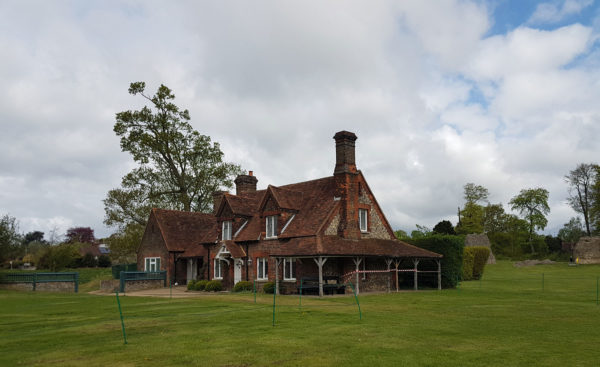The small commuter town of Berkhamsted sits on one of the most important sites in English history – the location of the formal surrender of the English to William the Conqueror.
And yet, most people haven’t heard of it.
After the Conqueror did his conquering against the Anglo-Saxons at the Battle of Hastings he marched around the heavily fortified London and took the formal surrender at an encampment in the Saxon village.
As the village was on an ancient Saxon road, it was a strategic location, and a wooden fortification was built to control the route to London. It was this which was to, over time, become the stone castle — one of the largest in the country at the time.

A reconstruction drawing showing how Berkhamsted Castle may have looked in about 1190. The south gateway of the castle led towards the town © Historic England (illustration by Dominic Andrews)
The castle is a classic Norman motte-and-bailey, with a tall defensive mound surrounded by high walls and two deep ditches. It once saw war, when King John was fighting the Barons, and they lay siege to the castle.
At one point the castle rivalled Windsor Castle in importance, and both Edward III and later Henry IV lived there. It was also at various times lent to minor Royals and royal favourites, such as Thomas Becket and the Black Prince.
However, the castle declined in importance over the years, and lacking maintenance started to fall into ruins in the 16th century. By the time of Elizabeth I’s time, the land and castle were being rented out for the peppercorn rent of “one red rose” per year.
The castle was nearly destroyed in the 1830s when the railway realised the castle was right in the path it wanted to take, but the emerging heritage lobby managed to preserve it — which was no mean feat considering the huge powers the railways had to buy up land.
The railway did manage to slice off part of the Castle edges, but was forced into a diversion. Today, many thousands of people see the castle on their commutes to work as they pass through Berkhamsted station.
Anyone can visit the castle though, as it’s now owned by English Heritage, and freely open to visit.
On a quiet Sunday morning, hardly anyone else was around, just a dog walker and a mum with a son out for a wander. It’s picturesque, with carefully maintained lawns in the centre, and the stonework preserved in places as patches of outcrops.
Rather incongruously, and yet oddly perfectly correctly in style, a house sits in the middle of the castle. This is occupied by the Keeper, which must make it one of the best “grace and favour” homes around.
What really strikes you though if you take a walk around the outer ditch embankment is just how big the castle must have been. It takes some time to walk all the way around, and you can’t easily get off the embankment for a short-cut once you start.
Some 900 years after they were dug, those ditches are still exceptionally deep and steep.
What looks like a series of life-saver rings actually had signs about anti-social behaviour on them, not rings to throw into the moat to save drowning people.
A series of modern rather ugly concrete steps lead up to the top of the motte, and up here it’s easier to see the scale of the castle grounds, and watch the trains pass by over the viaduct that sliced into the castle sides.
It’s a quirk of history that had this castle survived maybe another hundred years, it would today probably be fully intact and a major attraction. The streets nearby would be packed with tourist shops, and the area thronging with visitors.
English Heritage would probably make a fine income from admission fees.
Everyone would have heard of Berkhamsted.
But, history turned a different direction. The castle now sits on the “wrong” side of the railway, cut off from the town. No shops tout castle memorabilia, and no Monarchs pop up for a holiday. Hardly anyone knows about the town and its castle.
And English Heritage don’t charge an admission fee.
—
The castle is open daily, summer 10am-6pm, winter 10am-4pm. Closed Christmas Day and New Years Day.
I came up by train to Berkhamsted station, which is about 30 minutes from Euston. The town is pleasant enough, with plenty of old buildings, a canal to walk along, but not much else.
The castle and town can occupy a modest, but very enjoyable half-day visit.

















Berkhamsted is one of the finest towns I’ve ever been to.
Clearly you couldn’t have truly explored it.
You didn’t even mention the secret underground entrance to the castle dungeon!
And Ed Reardon lives there!
I was going to say that! Writing tip #34, never say ‘hardly anyone knows about it’…
There’s a secret underground entrance?!
And I do concur with Jordan; maybe a visit by bike would help, too. One weekend I cycled beyond the castle, into the network of bridleways and found ww2 trenches, and a sign detailing some history about the training camps in berkhamsted during the war. Most weekends I cycle west, into ashridge estate – in spring, the forest floor is blenketed by blue bells. (p.s. I enjoyed your last article on the ashridge memorial, Ian!).
Could make more of a day of it by going a short walk north to visit the wild boy’s grave at St Marys church in Nortchurch
Seriously you didnt do your research on the town, its amazing.
Berkhamsted is a historic market town close to the western boundary of Hertfordshire. It is situated in the small Bulbourne valley in the Chiltern Hills,26 miles north west.
Did you know Graham Green lived in Berkhamsted?
Love Berkhamstead. We have friends there and travel for an hour to go to the wonderful Art Deco cinema in the high street.